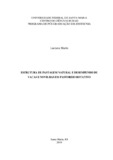| dc.creator | Marin, Luciana | |
| dc.date.accessioned | 2019-10-23T15:24:35Z | |
| dc.date.available | 2019-10-23T15:24:35Z | |
| dc.date.issued | 2019-02-22 | |
| dc.identifier.uri | http://repositorio.ufsm.br/handle/1/18653 | |
| dc.description.abstract | The beef cattle production in Rio Grande do Sul is based mainly on extensive breeding
systems where animal feed basis are natural grasslands. The present work aimed to evaluate
the forage production and the productive performance of heifers and cows managed in natural
grassland under the “first” and “last” grazers rotational grazing system. The treatments were
two rest intervals between grazing, from 402 degree-day and 252 degree-days, which
prioritized the growth of grasses of conservation and resource use groups, respectively.
Twenty-four tester heifers were used to constitute the “first” group and 24 tester cows
constituting the "last"group. The sward structure descriptors did not show treatment x period
interaction , the mean height were higher in the 402 GD treatment , total forage mass, forage
mass of lower stratum, density and % of structural components were similar between
treatments. The animal stocking was adjusted with regulatory heifers in the "first" group for
the intake of 70% of leaf blades in a forage mass above 1000 kg MS.ha-1. The daily weight
gain (DWG) of heifers was similar between rest intervals (P> 0.05) with a mean of 0.222
kg.day-1. Cow DWG was also similar between treatments (P> 0.05), with an average of 0.320
kg. day-1. The body weight gain per hectare was higher in the treatment of less rest interval,
where during the 149 days of experiment there was a gain of 117 kg. ha-1, whereas in the
treatment of a longer interval the gain was 95 kg. ha-1. The rotational grazing system with
"first" and "last" grazers provided satisfactory performances, proving to be a useful tool in the
rearing of heifers for mating at 24 months and termination of cull cows. | eng |
| dc.description.sponsorship | Conselho Nacional de Pesquisa e Desenvolvimento Científico e Tecnológico - CNPq | por |
| dc.language | por | por |
| dc.publisher | Universidade Federal de Santa Maria | por |
| dc.rights | Attribution-NonCommercial-NoDerivatives 4.0 International | * |
| dc.rights.uri | http://creativecommons.org/licenses/by-nc-nd/4.0/ | * |
| dc.subject | Bioma Pampa | por |
| dc.subject | Ganho médio diário | por |
| dc.subject | Massa de forragem | por |
| dc.subject | Ponta e rapador | por |
| dc.subject | Daily weight gain | eng |
| dc.subject | Herbage mass | eng |
| dc.subject | Pampa biome | eng |
| dc.subject | First and last grazing | eng |
| dc.title | Estrutura de pastagem natural e desempenho de vacas e novilhas em pastoreio rotativo | por |
| dc.title.alternative | Sward structure and performance of cows and heifers in rotational grazing | eng |
| dc.type | Dissertação | por |
| dc.description.resumo | A pecuária no Rio Grande do Sul é baseada principalmente em sistemas de produção
extensivos onde a base da alimentação de bovinos são as pastagens naturais. O presente
trabalho teve como objetivo avaliar a produção de forragem e o desempenho produtivo de
novilhas e vacas manejadas em pastagem natural sob o sistema de pastoreio rotativo com lotes
“ponta” e “rapador”. Os tratamentos foram dois intervalos de descanso entre pastejos, de 402
graus-dia e 252 graus-dia que priorizavam o crescimento de gramíneas dos grupos de
conservação e utilização de recursos, respectivamente. Foram utilizadas 24 novilhas testes
para constituírem o lote “ponta” e 24 vacas testes constituindo o lote “rapador”. A lotação
animal foi ajustada com novilhas reguladoras no lote “ponta” para o consumo de 70% de
lâminas foliares em uma massa de forragem acima de 1000 kg MS.ha-1. As variáveis
descritoras de estrutura da vegetação não apresentaram interação tratamento x período , a
altura média foi superior no tratamento 402 GD , massa de forragem total, massa de forragem
do estrato inferior densidade e % dos componentes estruturais foram semelhantes entre os
tratamentos. O ganho médio diário (GMD) das novilhas foi semelhante entre os intervalos de
descanso (P>0,05) com média de 0,222 kg.dia-1. O GMD das vacas também foi semelhante
entre os tratamentos (P>0,05), com média de 0,320 kg.dia-1. O ganho de peso corporal por
hectare foi superior no tratamento de menor intervalo de descanso, onde durante os 149 dias
de experimento houve um ganho de 117 kg. ha-1, enquanto no tratamento de maior intervalo o
ganho foi de 95 kg.ha-1. O sistema de pastoreio rotativo com lotes “ponta” e “rapador”
proporcionou desempenhos satisfatórios, demonstrando ser uma ferramenta útil na recria de
novilhas para acasalamento aos 24 meses e terminação de vacas de descarte. | por |
| dc.contributor.advisor1 | Quadros, Fernando Luiz Ferreira de | |
| dc.contributor.advisor1Lattes | http://lattes.cnpq.br/9202266292366562 | por |
| dc.contributor.referee1 | Pötter, Luciana | |
| dc.contributor.referee1Lattes | http://lattes.cnpq.br/0683474086643296 | por |
| dc.contributor.referee2 | Oliveira, Leandro Bittencourt de | |
| dc.contributor.referee2Lattes | http://lattes.cnpq.br/0652815976305762 | por |
| dc.creator.Lattes | http://lattes.cnpq.br/0748706744251144 | por |
| dc.publisher.country | Brasil | por |
| dc.publisher.department | Zootecnia | por |
| dc.publisher.initials | UFSM | por |
| dc.publisher.program | Programa de Pós-Graduação em Zootecnia | por |
| dc.subject.cnpq | CNPQ::CIENCIAS AGRARIAS::ZOOTECNIA | por |
| dc.publisher.unidade | Centro de Ciências Rurais | por |



